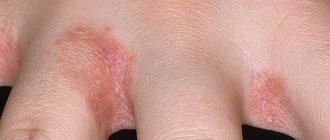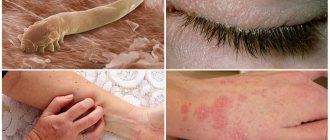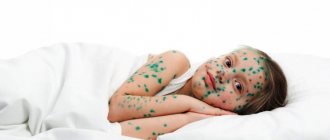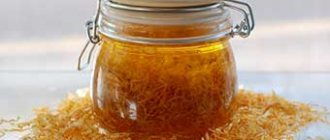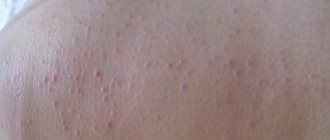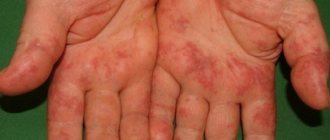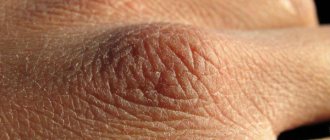Redness of the skin on the hands is not a disease in itself. But often the problem is a symptom of various disorders (not only when there is itching and flaking, but also in a number of other cases). Sometimes this can be a slight cosmetic defect, since this is how the body reacts to any external irritant. If the redness is accompanied by itching, the situation indicates an allergy or infection.
Signs of dry hands
Redness on the hands and dryness are signs of a lack of moisture in the surface layer of the epidermis. This layer contains a small amount of water, and if the humidity level is insufficient, the underlying layers of skin begin to actively evaporate moisture.
Subsequently, metabolic processes slow down, and the skin becomes dull and vulnerable. The epidermis on the hands dries out faster than on other parts of the body due to less subcutaneous fat.
Signs of dry skin on hands:
- feeling of skin tightness;
- frequent damage from the slightest impacts, peeling of scales;
- dull shade of the dermis;
- the occurrence of painful cracks;
- attacks of itching and irritation accompanied by scratching;
- the appearance of reddened areas;
- rough and inelastic skin;
- dryness around the nails and rough cuticles;
- roughness.
The simplest reasons
It should also be noted that regardless of the reasons that caused itching and redness on your skin, such phenomena can significantly increase the following factors:
- Constant contact with synthetic and chemical substances. Such products include: household chemicals, various lubricants, cosmetics, personal hygiene products, etc. It should be said right away that itching on a person’s skin can noticeably increase even in cases where he does not have an allergic reaction to everything listed connections. To restore your normal state, doctors recommend stopping the use of certain products (replacing them with others).
- Low humidity in the room in which the patient is located (less than 30%). As you know, dry air negatively affects human skin. They become excessively dry, resulting in unbearable itching, which intensifies over time and causes unpleasant peeling and redness.
- Excessive fluid loss. This condition can occur due to dehydration of the human body caused by severe vomiting, regular diarrhea, as well as prolonged exposure to high ambient temperatures and limited drinking water consumption. To treat dry skin in this case, it is necessary to replenish the fluid deficiency or take a drug that will help retain it (for example, with vomiting or diarrhea).
- Wearing wool or synthetic tight clothing. Dresses, shirts, trousers, etc., made from poor quality material, quite often cause itching and redness on the legs and arms. This state of affairs is significantly aggravated if clothes are too tight and worn in hot summer weather.
- Excessively long (more than half an hour) and frequent sitz baths, as well as excessively hot water, significantly increase redness on the skin. By the way, long water procedures, as well as increased water temperature, contribute to a strong expansion of blood vessels. This phenomenon leads not only to redness of the skin, but also to increased itching.
- Taking certain medications, excessive drinking of alcoholic beverages and drug use also contribute to the development of these pathological conditions. In addition, redness and itching of the skin can occur as a result of food intoxication. It should be noted that many dyes and additives contribute to such phenomena. Therefore, before purchasing any product, it is recommended that you familiarize yourself with its composition. If there are too many “E”s in it, then it is better to discard it. Otherwise, you cannot avoid skin problems.
It should also be noted that prolonged emotional stress very often contributes to itching and redness of the skin. To avoid such conditions, it is necessary to avoid unpleasant situations and carefully monitor your mental state (if necessary, consult a psychotherapist).
Causes of redness and dry skin on the hands
Many factors directly affect the condition of the skin of the hands. This includes compliance with hygiene rules, the level of immunity, and lifestyle.
The main causes of dryness and redness of the epidermis on the hands include:
- the influence of unfavorable environmental factors (scorching sun or frosty weather, dry and windy climate, air pollution);
- use of inappropriate hygiene products, as well as frequent hand washing with hot water;
- cleaning with detergents without gloves;
Redness on the hands and dryness may occur after cleaning without gloves. Therefore, it is recommended to purchase these to keep your skin healthy.
- unhealthy lifestyle and metabolic disorders in the body;
- constant use of heating appliances or air conditioning in unventilated areas;
- result of taking medications;
- frequent stressful situations;
- allergy;
- insect bites;
- aging of the body.
Redness on the hands and dryness are also symptoms of various diseases.
These include:
- Eczema: an acute or chronic inflammatory disease accompanied by rash, itching or burning. The skin appears thickened and inflamed.
- Contact dermatitis: the result of the influence of an irritating substance on the dermis, causing allergic manifestations. The skin becomes red, swollen, and blisters may form.
- Urticaria: a condition of the epidermis characterized by the presence of itchy reddish formations. It is quickly detected and goes away within a day.
- Scabies: a parasitic disease caused by a microscopic mite and accompanied by severe itching. It appears as redness and rash between the fingers, as well as in areas with thin skin.
- Skin fungus: a disease caused by different types of fungi. Manifests itself in the form of red pimples and peeling. Nail fungus may develop.
- Lichen planus: a chronic disease that affects the dermis and mucous surfaces of the body. The formation of small dark red nodules merging into plaques is characteristic.
- Candidiasis: a disease caused by yeast. There is itchy redness of the skin with a white coating between the fingers.
- Hypothyroidism: a condition of the body with low levels of iodine-containing hormones. Dry skin, drowsiness, and swelling of the extremities are observed.
- Psoriasis: a skin disease that appears due to disruptions in the nervous and endocrine systems or problems in the body's metabolic processes. The skin dries out and becomes inflamed, begins to swell and peel.
- Diabetes mellitus: changes in the metabolic process due to lack of insulin. May be accompanied by dryness in the folds of the dermis.
- Herpes: a viral infectious disease. It is characterized by the appearance of itching and rash followed by the formation of small blisters.
- Hypovitaminosis A and PP: lack of these vitamins in the body. Manifests itself in general dryness and flaking of the epidermis.
- Sjogren's disease: a connective tissue disorder characterized by exocrine glandular and extraglandular manifestations. Dry skin, blurred vision, and stomatitis are observed.
Red palms of hands: illness or harmless and temporary defect
Most organ diseases can be diagnosed by the appearance of the skin, in particular the palms.
Some patients complain to the doctor that their palms are red and itchy.
You need to talk to your doctor about this, because such an unpleasant sign can indicate problems in the body. To protect yourself from unnecessary worries, you need to know what redness looks like depending on the disease.
In rare situations, red palms are considered the absolute norm. For example, during pregnancy, a woman’s blood vessel activity increases significantly. In another case, this condition of the hands may be a congenital phenomenon, this is explained by the location of the vessels too close to the surface of the epithelium.
But in some cases, the causes of red or pink palms are much more serious.
The cause of redness of the skin of the palms, the unexpected appearance of small red pimples, may be an allergic reaction. Allergen provocateurs in such situations are almost always chemical elements from household chemicals and decorative cosmetics, food products and some medications.
In the absence of effective treatment, increased sensitivity of the immune system to a certain substance can lead to the appearance of a chronic form of skin dermatitis and eczema.
Perhaps she has ceased to cope with a large number of toxic substances that come with food, alcohol, or as a result of an infectious disease or long-term use of medications. The reason why both palms are red on the hands may be cirrhosis of the liver or hepatitis.
The photo shows red, painful-looking palms with cirrhosis:
Rarely, hyperemia of the palms indicates hypovitaminosis. Scarlet palms with regular numbness in the fingers and hands, burning and itching of the hands indicate a lack of B vitamins in the body. Almost always, this disease occurs against the background of poor nutrition, which negatively affects the functioning of the cardiovascular system, central nervous system, and immunity.
Another cause of red skin on the palms of an adult is palmar psoriasis. With this disease, extensive dropsy with a loose structure may appear on the surface of this part of the hands. Similar manifestations of psoriasis can occur in other areas.
The causes of pronounced red palms in a child can be no less serious. This condition sometimes indicates an allergy or infection.
Sharp redness in a child's palm may indicate the beginning of the development of a chronic disease. The unformed body of a child is highly prone to the formation of congenital allergic diseases. The most common pathology of an allergic nature is considered to be atopic dermatitis.
In infants, the symptom may indicate pathologies of the liver and kidneys. In any case, for an accurate diagnosis and effective treatment, you should consult a dermatologist who will tell you why your child’s palms turn red.
A sign of what disease is the red covering of children's palms:
Peeling and redness of the skin on the fingers is a phenomenon that almost every second person in the world faces. In most cases, it goes away on its own after some time.
But in some situations, if your fingers are red, you need to be seriously examined and begin effective treatment. This measure is especially important if a person has not consulted a specialist for a long time or is concerned about other symptoms besides redness of the hands or just the palms.
It happens that an infection that entered the body a few days ago can appear in the form of fingers with an unusual color only after a couple of days or even weeks. For this reason, it is important to remember everything that could have caused it, since the doctor will definitely ask about the alleged irritant and contact with a sick person.
There is no need to rule out a fungus or an inflammatory disease.
If we consider everyday reasons for changes in the color of the fingers of the upper extremities, it may be an unexpected change in climate, cold air.
Fingers may change color due to strong exposure to hot air or water. This is because at high temperatures, blood vessels have the ability to expand, resulting in a powerful rush of blood, which contributes to redness.
The reasons why palms are itchy and red may be associated with an unbalanced diet, excessive consumption of fried, salty or sweet foods. You should avoid frequent consumption of fast food, carbonated and alcoholic drinks, and canned food. They can not only increase weight, but also significantly worsen health conditions.
In order to find out what red palms are talking about, you need to see a doctor.
In this case, a dermatologist helps. If necessary, he refers you to another specialist with a narrow focus. You can see a therapist.
The doctor externally assesses the condition of the skin, looks for the presence of other signs (rash, inflammation, peeling), mobility of the entire hand and finger joints. Based on this, certain conclusions are drawn, and if necessary, a skin scraping is taken to make a more accurate diagnosis. It is mandatory that all patients are sent to donate blood and urine for a general analysis.
Finding out the cause and determining the appropriate treatment is something that should be done by the doctor, not the patient. After carrying out diagnostic measures, he explains why certain parts of the body turn red, the cause of which dangerous or minor disease is the symptom. There is no need to worry until this moment. Patience and following the prescribed treatment will help overcome the problem.
Medicinal ointments and moisturizing creams against redness, flaking and dry skin of the hands
Ointments and creams for redness and irritation of the skin must be in your home medicine cabinet in order to provide prompt assistance to reddened and flaky areas in a timely manner.
List of the most common means:
- "Radevit" is an ointment that has an anti-inflammatory effect and accelerates the regeneration of the epidermis. Relieves itching, softens, and enhances the protective properties of the skin. The affected areas of the hands are treated with an antiseptic, then a thin layer of ointment is applied (1-2 times a day).
- Zinc ointment has an antiseptic effect, reduces inflammation and irritation of the dermis. The product is applied to clean and dry hands up to 6 times a day.
- "Elidel" has a high anti-inflammatory effect. The cream should be rubbed into the affected areas until completely absorbed. Used 2 times a day.
- Panthenol ointment is used to treat cracked and rough skin and heal microdamages. The product can be used several times a day, as needed.
Ointments against viral and fungal skin lesions on the hands and between the fingers
If herpes rashes appear on your hands, Acyclovir, Zovirax or Herpevir ointments will help reduce itching and burning, as well as speed up healing. The product is applied using a cotton pad every 4 hours.
For fungal diseases of the dermis, the use of Candide cream is indicated, which reduces the proliferation of bacteria and the development of fungi. A thin layer of cream is rubbed into clean, dry skin 1-3 times a day.
The antifungal drug Lamisil is also widely used. The method of use is similar.
Additional symptoms
Some clinical features of the disease help to make a diagnosis. Here are several options for redness.
Only red spots
If there is no itching on the skin, and only red spots bother you, the most likely causes of the disease are the following:
- Insect bites.
- Some fungal diseases, for example microsporia.
- Systemic lupus erythematosus and cutaneous forms of lupus.
- Disorders of the autonomic innervation of the skin.
Isolated redness of the skin without other symptoms should not be ignored. After all, additional manifestations may arise later.
If it itches
The most common clinical picture is a combination of redness and itching. It can occur with all of the diseases listed above.
Cosmetics against dryness and flaking
Cosmetic antioxidant cream "Librederm" perfectly solves the problem of dry and rough skin of the hands thanks to the content of vitamin E and allantoin. The cream eliminates the feeling of tightness, irritation disappears and the protective properties of the skin are restored. Use as needed and is quickly absorbed.
Hand cream “Nivea” (Nutrition and Care) perfectly softens hands, smoothes out unevenness and improves the tone of the epidermis. A small amount of product is enough for quick results.
"Decleor" is a cream containing extracts of medicinal herbs. Rescues chapped and dry hand skin and also reduces the first signs of aging. Quickly softens and moisturizes the skin.
Red hands and feet cause and treatment
Hello, dear readers and our subscribers!
Hands are one of the first parts of the body to show signs of aging.
However, in addition to this, their condition may indicate various health problems. Doctors are confident that the appearance of the hands may be due to some changes occurring in other parts of the body.
12 symptoms you should pay attention to to stay healthy!
1.
Red palms.
Doctors say that redness of the palms or erythema may be a sign of liver problems. Especially if you are over 50, the redness is usually localized on the outside of the palm or near the wrist. In extreme cases, it can reach the fingers. At first glance, the redness looks like a rash and if you press on the skin in this area, it will turn white. This sign in itself is not dangerous or harmful, but it clearly indicates other problems. One of the possible causes of red palms is a change in hormonal balance causing vasodilation, which is why this condition occurs in pregnant women. Rheumatoid arthritis
There may also be reasons for redness of the palms. However, most often erythema is caused by liver diseases such as cirrhosis or Wilson's disease. If you notice redness on your palms, consult a doctor to find out the cause, and also eat healthy foods and reduce your alcohol intake.
2. Sweaty palms
.
Sweaty palms can be caused by several reasons. Hyperhidrosis or excessive sweating? which is usually inherited, stress, excessive activity of the thyroid gland leading to overheating of the body, and in addition, the cause of this condition can also be excessive alcohol consumption.
If you have hyperhidrosis or excessive sweating, try using an antiperspirant that suits you. You can also take medication to combat sweaty palms. Try to drink less alcohol and control your stress levels. Meditation and breathing techniques can help you cope with unpleasant situations. If nothing works you should see a doctor. Procedures such as iontophoresis, when you place your hands in a vessel of water through which a weak current is passed at that time, help 70-80% of people with this problem.
3.
Loss of sensation and tingling.
Sometimes you wake up with a feeling of loss of sensation in certain parts of the body, and when you move they begin to tingle. This usually happens because you apply pressure to a sensory nerve for too long. The tingling lasts as long as the nerve needs to recover. However, in some cases, such symptoms in the arms may indicate more serious problems such as cervical osteochondrosis, carpal tunnel syndrome, vein thrombosis in the extremities, shoulder injury, brachial plexus injury, anemia or diabetes. If you frequently experience loss of sensation in your hands for no apparent reason, consult your doctor.
4.
Dry hands.
The most common causes of dry hand skin are dehydration, low thyroid function, fatty acid deficiency, or estrogen deficiency that precedes menopause. To stay hydrated and drink water, and use hand moisturizer to combat fatty acid deficiencies, make sure your diet includes fatty fish, seeds and nuts. See your doctor for hormone replacement therapy. It will help restore estrogen levels.
5.
Trembling hands.
It may come as a shock, but idiopathic tremor is a major problem for 4% of people over 40 years of age. This condition can make life miserable as tremors interfere with everything you do, from drinking from a glass to writing down important information. Today we know that hand tremors can be a sign of serious problems, such as Parkinson's disease, but there may be other causes if you have an overactive thyroid gland, it can speed up your metabolism, cause sweating, rapid heartbeat, anxiety, insomnia and hand tremors . If you are experiencing extreme stress or anxiety, your hands may also shake. However, the most common cause is excessive consumption of coffee or alcohol. If in doubt, seek advice from your doctor.
6.
Brittle nails.
Salon procedures for the treatment of dermatological diseases on the hands
There is a range of different procedures for the treatment of dermatological diseases:
- Laser therapy: used for allergic manifestations, fungal diseases, to weaken local inflammatory processes. Laser radiation has analgesic, vasodilating, and muscle relaxant effects. The course consists of 12 sessions, repeated procedures are possible no earlier than after 3-4 weeks.
- To enhance the effect of drugs in the treatment of skin diseases, electrophoresis is used. To carry out a physiotherapy procedure, a pad soaked in medicine and an electrode through which an electric current is applied are placed on the affected area of the skin. The course of treatment consists of 10-20 procedures, which are carried out daily or every other day. There are contraindications for damaged skin.
- UHF therapy. The properties of ultra-high frequency current are used for treatment. The procedure has a bactericidal effect, stimulates the protective properties of the epidermis, and accelerates tissue restoration. The course of treatment includes 5-15 procedures lasting up to 15 minutes.
- Darsonvalization is a method of electrotherapy using alternating current. The procedure has an analgesic, antipruritic effect, and improves blood circulation. Session time – 10-20 minutes, full course – 10-15 physiotherapy procedures.
Oil wraps against cracks and itching on hands
You can get rid of redness and dry skin on your hands by using oil wraps. This procedure helps to enrich the underlying layers of the epidermis with nutrients.
Natural vegetable oils containing the necessary vitamins, minerals and enzymes are used for wrapping. Thanks to the influence of biologically active substances, blood circulation improves, metabolic processes are activated, and the elasticity of the dermis increases.
The most effective oils for wrapping:
- grapefruit (saturates cells with oxygen, stimulates blood circulation, smoothes out unevenness);
- geranium (increases skin tone, refreshes);
- orange (eliminates dryness and heals microdamages, suitable for sensitive skin);
- peach (moisturizes aging and dry skin);
- lemon (restores smoothness and elasticity);
- cinnamon (accelerates regeneration, improves the appearance of the epidermis in old age);
- lavender (has anti-inflammatory and healing effects).
The wrap mixture consists of base olive oil and a few drops of active essential oil. Sometimes olive oil is replaced with honey. A thin layer of the mixture is applied to thoroughly cleansed skin, which is covered with plastic film on top.
This creates something like a “greenhouse” effect. After 20-30 minutes, the mixture is washed off with warm water. To obtain a sustainable result, the procedure must be repeated 10-15 times.
Main reasons
Red skin on the hands is a symptom of various diseases. It all depends on how exactly the redness manifests itself. Sometimes this is a sign of an insect bite - even small midges cause such a strong reaction in the body that the skin turns red, swelling and itching appear. In this case, a special ointment and balm are enough to help fight this phenomenon - Mosquitall and other drugs that are sold in a pharmacy or supermarket.
There are other reasons for redness of the skin on the hands:
Sometimes redness of the skin indicates inflammatory processes or diseases of the internal organs.
Possible diseases, the main symptom of which is redness of the skin:
| Disease | Description | Symptoms |
| Psoriasis | Sometimes red hands are one of the symptoms of psoriasis. This is a chronic autoimmune disease. The reasons for its appearance have not been sufficiently studied, but it is known that the impetus for its development is chronic stress and psycho-emotional overload. The hands do not turn completely red: raised red spots appear on them, and peeling occurs. Psoriasis is a type of lichen. The most severe form of this disease is pustular psoriasis, when the skin is covered with blisters of clear liquid, and there is redness and swelling around them. The skin may be hot to the touch due to inflammation. Dermatologists recommend starting treatment of the disease with local therapy with the least toxic ointments. Anti-stress therapy also plays an important role in psoriasis. | |
| Fungal infection | Its manifestations are similar to psoriasis. It also causes red spots on the skin of the hands and peeling. Localization varies, since the fungus often selects areas between the fingers. It is simply not possible to differentiate pathologies on your own, so if such symptoms appear, you need to consult a doctor. If you have a fungal disease, you will have to treat the skin with an antimycotic ointment, for example nystatin | |
| Eczema | First, the elbows turn red, pronounced spots appear on the legs and even on the stomach. The rash is observed on the fingers and the back of the hand. Another characteristic symptom is quite severe itching. Eczema is associated with various external factors. But often it appears in diseases of internal organs (kidneys, liver, gastrointestinal tract, pathologies of the endocrine system). Psycho-emotional stress also plays a role. In this case, treatment should begin by eliminating the cause of its appearance. To treat eczema, external agents and antihistamines, multivitamin complexes are used. Ointments based on corticosteroid hormones (hydrocortisone ointment) have proven themselves well. At the same time, take mild sedatives (valerian preparations) | |
| Allergy | Redness of the skin due to allergies has different types - contact or atopic dermatitis, urticaria. Many people think that these diseases occur more often in children, but such a reaction also develops in an adult with direct contact with an irritant, such as household chemicals. An allergic reaction is accompanied not only by redness, but itching and swelling. With urticaria, a complication can be angioedema, which makes breathing difficult. This is a rather dangerous condition. Allergies are treated with external corticosteroid ointments and second- and third-generation antihistamines (Zyrtec, Claritin, Erius, Histafen), since they have minimal side effects. Separately, it is worth mentioning cold allergies and reactions to ultraviolet radiation. In the first case, before going outside, you should apply any nourishing cream to your hands for additional protection. You can even use baby cream. You should always wear mittens or gloves outside. In the second - eliminate direct contact with the sun's rays | Hives |
| Scleroderma | If the skin turns red but does not itch, the problem is caused by scleroderma. This is an autoimmune disease in which the capillaries are damaged, leading to swelling and redness. Since pain in the fingers occurs at the same time, many people mistake such symptoms for arthritis, although the nature of the diseases is completely different. Enzyme preparations derived from hyaluronic acid are used to treat scleroderma |
If the skin turns red without itching, it is caused by stress. When a person is nervous, his pulse quickens, the hormone adrenaline is released, and under its influence the skin turns red. In this case, you need to take mild sedatives and learn non-drug ways to deal with stress, such as breathing exercises.
Compresses for cracks and itching on hands
Homemade compresses are one of the effective methods of caring for the epidermis of hands prone to dryness. If your hands have cracks and damage, a compress containing oil-based vitamin A will be effective. It is characterized by healing, nourishing properties, and also eliminates irritation.
Before using the compress, you need to steam the skin in a bath with chamomile or St. John's wort.
To carry out the procedure, a piece of cotton fabric is soaked in a medicinal agent and applied to the hands. The top of the compress is covered with film or paraffin paper and left for 20 to 40 minutes.
Gelatin compress increases the elasticity of the dermis and restores its healthy appearance. 3 tbsp. gelatin must be poured with water and wait until it is absorbed. Then the composition is heated, the fabric is soaked in it and applied to the hands. Keep the compress for 45-60 minutes, then wash it off with warm water.
Homemade ointments
If the dermis of your hands is dry and flaky, you can use folk recipes for homemade ointments. For example, a simple mixture that consists of equal parts of ammonia, glycerin and hydrogen peroxide.
This composition gives the skin softness and also has wound healing and analgesic functions.
No less effective is a mixture prepared from one yolk and 6 drops of aloe juice. The resulting ointment is applied once a day to the hands, the period of use is 10-14 days.
Baths for treating cracks and relieving itching
Redness on the hands and dryness can be easily eliminated using baths according to home recipes. For cracked, dry epidermis, it is useful to steam your hands in warm water with soda or sea salt (1 tablespoon per 1 liter).
You can also use the following compositions:
- 2 tbsp. potato starch is mixed in 1 liter of water;
- 3 tablespoons are steamed in 0.5 liters of water. flax seeds;
- 100 g of oats are brewed in 1 liter of water.
Hands should be kept in the bath for 15 minutes. It is advisable to carry out this procedure before going to bed; after this, pat the skin dry and apply a rich cream.
Reason for red hands
Content
hide
1 Red palms of hands: disease or harmless and temporary defect
2 What are the reasons for redness on the hands and how to deal with this phenomenon
3 Redness of the skin on the hands is not scary and can be easily treated
Typically, this problem indicates poor circulation. These may be chronic heart diseases, consequences of minor frostbite, or the influence of hereditary diseases.
One way or another, red hands indicate sluggish blood circulation. If no measures are taken, the hands may even acquire a bluish tint, and the skin becomes cold and itches when warm. In the future, cracks, blisters and sores may appear on the hands. In general, if you have red hands, then you will have to take good care of them and keep them warm.
To make your hands smooth and soft again, start carrying out the following procedures right now:
- Your morning should begin with special gymnastics, which takes only 15 minutes, but perfectly activates blood circulation.
- Place your fingertips on the wall. Using your fingers to support yourself, touch the wall with your palm. Lift your palms off the wall, returning to your original position. Do this several times.
- Raise your arms to chest level in front of you. Raise and lower your hands 20 times.
- Clench your hands into a fist several times and unclench them back.
- Using your thumbs, rotate 20 times in one direction, and then another 20 times in the other.
- Shake your left hand with your right, as if shaking hands, now with your left hand.
- Bring your fingertips together at chest level. Press them against each other and release.
- Rotate your hands in one direction or the other for one minute.
- Shake your arms freely from your shoulder downwards several times.
- At the end of the gymnastics, apply protective hand cream. The cream should be rubbed in with movements as if putting on gloves, that is, from the end of the fingers to their base, and then with the entire palm to the wrist.
- During the day, whenever possible, rub your hands with fresh milk in winter and cucumber juice in summer.
- In the evening, red hands require special care. It is advisable to start with contrasting baths. In a simple version, alternately lower your hands first into a container with cool water (for 10 seconds), and then into a container with warm water for 15 seconds. Finish with cold water after 10-12 alternations. For the best effect, add 1 dessert spoon of infusions of marsh calamus and nettle tubers to hot water, and 1 dessert spoon of oak bark decoction to cool water.
- Now it's time to massage with rich cream.
You can use any cream, but the following one has worked well: take 1 tbsp. wheat germ oil, 15 g cocoa butter, 7 g beeswax, 2 tbsp. almond oil, one pea of vitamin E oil solution, 2 drops each of rose, geranium and black pepper oils. Mix the ingredients in a bowl placed in a water bath. Stir continuously until a homogeneous mixture forms. Now remove the bowl from the heat and, stirring slowly, add 7 teaspoons of rose water. Place the resulting cream in a glass jar, close it and put it in the refrigerator. In a simpler version, you can use a massage cream, rubbing your hands with it until you feel warm. - After the massage, add a little more cream to your hands, put on cotton gloves and leave them on overnight.
If your hands are still red after two weeks, you should see a doctor. You may be prescribed ointments and medications that dilate blood vessels. In some cases, diathermy may be prescribed - deep heating of tissues using high-frequency electric current.
Tips for caring for dry hands
To solve the problem of dry skin caused by a lack of vitamins, you should add green vegetables, whole grain cereals, fatty fish, eggs, dairy products, liver, nuts and rye bread to your diet.
It is recommended to adhere to the following rules for caring for dry skin on your hands:
- Do household work with detergents using rubber gloves;
- use soap containing moisturizing ingredients;
- After washing your hands, dry them gently with a towel;
- in cold weather, do not go outside without gloves, and in hot weather, use sunscreen;
- wash your hands in warm water and then rinse with cold water;
- In the morning and before bed, rub glycerin-based cream into the skin;
- weekly cleanse the upper layer of the epidermis with a scrub;
- do not apply moisturizer before leaving home;
- It is advisable to purchase an air humidifier;
- try to eat right and drink more fluids.
By the appearance of your hands you can judge the general condition of the body, so redness, dryness and irritation on your hands are a reason to devote more time to your health and, in particular, to caring for the skin of your hands.
Causes of red fingers
Red fingers and palms of the hands can be the result of various factors. Here are just a few reasons for redness:
- Atopic dermatitis.
- Allergies to medications, food, environmental factors.
- Insect bites.
- Erysipelas and other infectious diseases of a bacterial nature.
- Fungal skin lesions.
- Dyshidrotic eczema.
- Inflammation in autoimmune diseases: systemic scleroderma, dermatomyositis.
Many of these conditions are still considered quite rare. In most cases, redness and peeling of the skin occur due to atopic dermatitis and allergies.
Can water cause irritation?
Patients often associate redness of the skin of their hands with exposure to water. This is indeed possible under the following conditions:
- Weeping eczema. With this pathology, due to autoimmune disorders and pathology of the neuroendocrine system, bubbles with clear liquid appear on the hands. With increased skin moisture at the site of the lesion, they have difficulty healing and only progress. If work or household activities involve frequent washing or laundry, then it is very difficult to overcome such a disease.
- Allergy to substances contained in water. Only distilled water is considered absolutely pure, while running and spring water contains a large amount of trace elements and other substances. A person may be intolerant to any of the components of this “cocktail”. Therefore, it is likely that allergies will develop.
Skin reaction to water is often observed when a person moves. The skin has already adapted to one composition of the liquid, but serious changes in the composition cause an intolerance reaction.
Features of a child
Skin changes on the hands and wrists can occur at any age: in the newborn period, at 2 years and beyond. The following may contribute to the reaction in children:
- Allergic diseases in mother and father.
- Taking medications during pregnancy.
- Early introduction of allergenic foods into complementary feeding.
- Eating preservatives.
- Hereditary predisposition.
Redness and itching on the skin of children can also be not only allergic. Atopic dermatitis is one of the most common causes.
A child does not always notice insect bites, so this factor should not be ruled out when redness is detected.
But autoimmune diseases (dermatomyositis and systemic scleroderma) rarely occur in children, although their occurrence is also possible.
